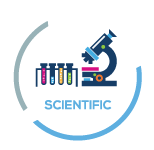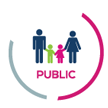Methodology
MAPEC was a multicenter epidemiological cohort study that involved 1,149 6-8 years old children of five Italian cities (Brescia, Lecce, Perugia, Pisa and Turin), characterized by different levels of air pollution.
The following analysis were performed for each area:
a) Exposure to air pollutants:
- Chemical analysis on the organic component (IPA and nitroIPA) of the PM 0.5 by air collection with an high volume sampler;
- Mutagenicity tests in vitro (Ames test on bacteria, Comet assay and micronuclei test (MN) on lung cell lines) on the same samples;
- Toxicity testing of PM 0.5 samples on lung cell lines (A549) on the same samples;
- Data collection of chemical parameters most commonly detected in urban air by ARPA;
b) The possible interaction of factors:
- A questionnaire on demographic and socio-economic presence of disorders and respiratory diseases, indoor environmental exposures and outdoor, nutrition, physical activity and other aspects of the lifestyle was spread to children parents;
c) Early biological effects:
- Buccal cells samples were assessed for the presence of DNA damage by Comet assay (protocol at pH> 13 and protocol for the oxidative damage) and the MN test.
No genetic analysis were performed on cells taken the children.
Finally two models for the calculation of the early biological effects risk in children was used. The first permits to assess the impact on health from exposure to pollution (risk analysis) leading to quantify an excess of undesirable events correlated with the exposure situation in a contaminated environment. The comparison between the risk estimation of carcinogenic effects produced by the model and the results of DNA damage on buccal cells was used to assess the goodness of the model for the biological effects prediction in children.
Moreover a comprehensive model for the calculation of the risk of early biological effect of exposure to air pollutants, including not only the environmental variables, but also the other factors taken into consideration was created.
Sample size. The large number of children involved in 5 cities, 1000, is due to the significant differences in the considered parameters (MN and DNA damage in buccal cells) among children living in areas with high exposure to air pollutants and those in areas at a lower level of pollution. On the basis of recent studies it can be expected to detect with the Comet assay DNA damage, expressed as a percentage of DNA migrated in the comet tail (tail intensity, TI) of about 10%, on average, in subjects with greater exposure vs 7% in those with lower exposure, with a maximum standard deviation of 10%. The sample of children included in the research was dichotomized based on the median of the distribution of air quality parameters considered.
Assuming a log-normal distribution of the variable under study, we can then observe a statistically significant difference between the two groups, above and below the median, respectively, with an alpha error of 0.05 and a power greater than 95 % by performing a Student's t test for independent groups two-tailed.
Recruitment period. From September 2014 to March 2016. To analyze the possible dose-effect relationship between exposure to pollutants and biological effects, air and biological samples was collected in the same children and in the same area in times characterized by different levels of air pollution: the 2014-2015 winter and late spring of 2015. Moreover, to assess the intra-subject biological variation, only children recruited in Brescia was analized for a third sampling period in the following winter season (2015-2016).
Recruitment. 2 or 3 schools located in different areas of the city was choosen in each city will be identified. Meeting with the school management and children parents were organized to explain the project and invite to participate. A total of 250 children was included for each city; a total of 1,149 children was recruited for the full study.
Children with serious illnesses and/or within the last 12 months, radiotherapy, chemotherapy, radiographic examinations and presence of orthodontic appliances were excluded from the research. An informed consent from the parents was collected to permit children to study participation. The confidentiality of the data collected was treated in accordance with the regulations (privacy).
Ethical aspects. The project was submitted for approval, to Ethics Committee of Brescia ASL responsible for the research manager area (Brescia), and then in each of the other 4 cities (Lecce, Perugia , Pisa and Turin), which was carried out in the recruitment of children. The documents was provided to children parents. All data were collected and analyzed according to the provisions of Legislative Decree n. 196 dated 30/6/2003 "Code regarding the protection of personal data" and subsequent amendments, for the purposes of research.
The following analysis were performed for each area:
a) Exposure to air pollutants:
- Chemical analysis on the organic component (IPA and nitroIPA) of the PM 0.5 by air collection with an high volume sampler;
- Mutagenicity tests in vitro (Ames test on bacteria, Comet assay and micronuclei test (MN) on lung cell lines) on the same samples;
- Toxicity testing of PM 0.5 samples on lung cell lines (A549) on the same samples;
- Data collection of chemical parameters most commonly detected in urban air by ARPA;
b) The possible interaction of factors:
- A questionnaire on demographic and socio-economic presence of disorders and respiratory diseases, indoor environmental exposures and outdoor, nutrition, physical activity and other aspects of the lifestyle was spread to children parents;
c) Early biological effects:
- Buccal cells samples were assessed for the presence of DNA damage by Comet assay (protocol at pH> 13 and protocol for the oxidative damage) and the MN test.
No genetic analysis were performed on cells taken the children.
Finally two models for the calculation of the early biological effects risk in children was used. The first permits to assess the impact on health from exposure to pollution (risk analysis) leading to quantify an excess of undesirable events correlated with the exposure situation in a contaminated environment. The comparison between the risk estimation of carcinogenic effects produced by the model and the results of DNA damage on buccal cells was used to assess the goodness of the model for the biological effects prediction in children.
Moreover a comprehensive model for the calculation of the risk of early biological effect of exposure to air pollutants, including not only the environmental variables, but also the other factors taken into consideration was created.
Sample size. The large number of children involved in 5 cities, 1000, is due to the significant differences in the considered parameters (MN and DNA damage in buccal cells) among children living in areas with high exposure to air pollutants and those in areas at a lower level of pollution. On the basis of recent studies it can be expected to detect with the Comet assay DNA damage, expressed as a percentage of DNA migrated in the comet tail (tail intensity, TI) of about 10%, on average, in subjects with greater exposure vs 7% in those with lower exposure, with a maximum standard deviation of 10%. The sample of children included in the research was dichotomized based on the median of the distribution of air quality parameters considered.
Assuming a log-normal distribution of the variable under study, we can then observe a statistically significant difference between the two groups, above and below the median, respectively, with an alpha error of 0.05 and a power greater than 95 % by performing a Student's t test for independent groups two-tailed.
Recruitment period. From September 2014 to March 2016. To analyze the possible dose-effect relationship between exposure to pollutants and biological effects, air and biological samples was collected in the same children and in the same area in times characterized by different levels of air pollution: the 2014-2015 winter and late spring of 2015. Moreover, to assess the intra-subject biological variation, only children recruited in Brescia was analized for a third sampling period in the following winter season (2015-2016).
Recruitment. 2 or 3 schools located in different areas of the city was choosen in each city will be identified. Meeting with the school management and children parents were organized to explain the project and invite to participate. A total of 250 children was included for each city; a total of 1,149 children was recruited for the full study.
Children with serious illnesses and/or within the last 12 months, radiotherapy, chemotherapy, radiographic examinations and presence of orthodontic appliances were excluded from the research. An informed consent from the parents was collected to permit children to study participation. The confidentiality of the data collected was treated in accordance with the regulations (privacy).
Ethical aspects. The project was submitted for approval, to Ethics Committee of Brescia ASL responsible for the research manager area (Brescia), and then in each of the other 4 cities (Lecce, Perugia , Pisa and Turin), which was carried out in the recruitment of children. The documents was provided to children parents. All data were collected and analyzed according to the provisions of Legislative Decree n. 196 dated 30/6/2003 "Code regarding the protection of personal data" and subsequent amendments, for the purposes of research.
-
-
-
-
-
-
-
-
16/11/2016 - CONFERENCES
49° Congresso Nazionale Società Italiana di Igiene e Medicina Preventiva
Naples, 16-19 November 2016 -
-
-
21/09/2016 - CONFERENCES
XVI National Congress of Environmental Chemistry and Cultural Heritage
Lecce, 26-29 june 2016 -
21/09/2016 - CONFERENCES
28th annual conference International Society for Environmental Epidemiology
Rome, September 1 – 4th 2016 -
21/09/2016 - CONFERENCES
52nd European Congress of the European Societies of Toxicology
Seville, September 04-07, 2016. -
21/09/2016 - CONFERENCES
International Conference of Environmental and Occupational Health
21-23 june 2016. Porto -
-
-
19/10/2015 - CONFERENCES
8th European Public Health Conference
14 - 17 October 2015. MiCo, Milan, Italy -
13/10/2015 - CONFERENCES
48° Congresso Nazionale SItI 2015
Milano Congressi (MiCo), Milan, Italy 14–17 October 2015 -
07/10/2015 - CONFERENCES
17th International Conference on Environmental Pollution and Public Health
14-15 September 2015 -
-
-
-
27/11/2014 - CONFERENCES
Abstract South Italian Mapec Workshop
Lecce, Hotel Hilton Garden Inn, 27 November 2014 -





